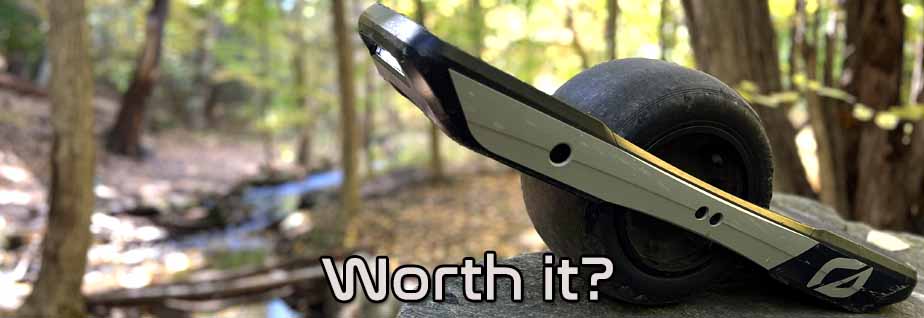
How much does it cost to own a onewheel? You may have heard that onewheels are expensive. While the initial investment into the board can range from $1,050 to $3,200, there is little maintenance costs afterwards. So are Onewheels worth the money?
Onewheels are absolutely worth buying. The initial cost may be the main drawback in your buying decision however there is little maintenance costs afterwards. They are fun and practical as they provide recreation enjoyment and double as a portable commuting device. Typical cost for a new Onewheel will range from $1,050 to $3,200 USD.
I have personally owned multiple onewheels over the past 2 years and the biggest regret was that I didn’t purchase one sooner and that I didn’t just go with the larger board (I am a sucker for range. I need a board with lots of range). Onewheels have this incredible ability in adding excitement to mundane and boring days. The ‘Pint’ is Future Motion’s entry-level Onewheel. This was personally the gateway board I took into the Onewheel cult-like following. Here is the cost of each board along with a recommended weight limit.
| Onewheel Model | Starting Cost | Battery Range | Recommended Weight Limit |
| Pint | $1,050 | 6 to 8 miles | 250 lbs |
| Pint X | $1,400 | 12 to 18 miles | 250 lbs |
| XR | $1,799 (discontinued) | 12 to 18 miles | 275 lbs |
| GT | $2,200 | 20 to 32 miles | 275 lbs |
After the initial purchase, accessories are available for purchase. They are very alluring because who doesn’t want to personalize and customize their one wheel? That being said, few (if any) are necessary. Also worth mentioning is that there are only a few components on the Onewheel that need maintenance. I have over 1000 miles on my Pint and the tire, bearings and grip tape are in great shape. Future Motion provides a tune-up service for many of the components. So typical one wheel maintenance cost will run less than $300 every couple thousand miles or so.
How Long Can a Onewheel Last For?
I have a more exhaustive post on the lifetime of Onewheel components. In short though, the body of the board will likely outlive its components. Some components (such as the bearings) will not need replacing for thousands of miles. The Onewheel’s longevity is based on how frequently you ride. Without any maintenance, Onewheels will last for thousands of miles. The main wearables are the tires, bumpers and batteries. I have personally ridden my Onewheel over 1000 miles on trails and the tire, bumpers and battery are in great shape. It all depends of how much riding you do.
Here is the expected lifetime of the Onewheel components:
| Onewheel Part | 5 weekly miles | 10 weekly miles | 50 weekly miles | 100 weekly miles |
| Tire | 4 to 5 Years | 2 to 3 Years | 6 Months to 1 Year | 3 to 6 Months |
| Bearings | 10 Years | 5 to 7 Years | 1 to 2 Years | 6 months to 1 year |
Tires generally go with a 1500 -mile benchmark for assessing replacement. Of course this will vary depending if you ride extremely hot asphalt vs trails. Hot surfaces will tend to wear the tire out quicker. A visual of your tire will tell you if it needs replacing. Any signs of tire threads and it is time. The cost of a tire is around $80 to $120 and can be done with basic tools.
Bearing swaps are more challenging and require a press to complete. A typical repair shop like Stoke Life Services typically charge $125-$150 for bearing swaps. Bearings will cost about $100 for the parts so a complete bearing swap would run $225-$250. Note however that stock bearings may last over 2000 miles. If you feel resistance, hear griding or If the ride feels ‘gritty’, its time for a bearing swap.

Both components, it total may cost you about $400 over the life of 2 years. Onewheel bumpers are around $60 however if you use float plates they limit the contact of the bumper. These may never need replacing. It will depend on how often you quickstop (skidding stop).
Onewheel Battery Life
Regardless of what model Onewheel you have, the Onewheel has a lithium-ion battery. Battery degradation primarily occurs on how many cycles have been completed on the battery. Onewheels have Lithium Nickel Manganese Cobalt Oxide batteries (LiNiMnCoO2) which are incredibly tolerant to repeating cycling. Generally, Lithium Nickel Manganese Cobalt Oxide can withstand 3000-5000 cycles. Likely however you will see some degradation of the battery after 1000 cycles. The general rule is know the stock range of the Onewheel (in optimal conditions). If you can no longer achieve 75% of that range, it may be time to replace the battery. See my post on proper Onewheel battery maintenance.
A typical battery should last over 1000 miles with little degradation assuming the battery has been properly maintained. While Future motions does not sell batteries, there are several companies (CHI or JW Batteries) that sell replacements ranging from $350 to $700 depending on cell size. It is to note however not all models have the ability to swap the batteries out. A battery swap completed by yourself does void the warranty. While some boards require chipping, boards like the GT currently do not have an option for a battery swap as of yet. There are also Onewheel-alternative brands to look into.
Conclusion
Over the course of 1000 to 2000 miles you may have to complete these maintenance items. Items such as footpads and sensor should last longer however they too are fairly inexpensive items. For an optimal performing onewheel, after 2000 miles expect to pay approximately $500 to $900 in maintenance. With a clean board, it holds its value so consider it an investment and assurance you are on a safer board knowing that its been properly maintained. Its a trite saying however it is so true relating to onewheels , “you can’t put a price on happiness”.
I never in my life thought I would consider spending hundreds on parts and accessories however when you float around, you understand. In reality however accessories are not needed but do make for a more enjoyable ride (sometimes).
